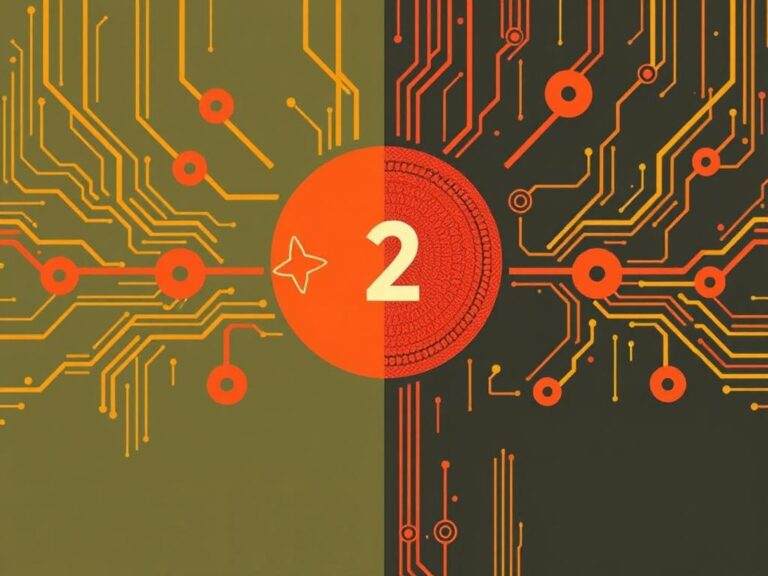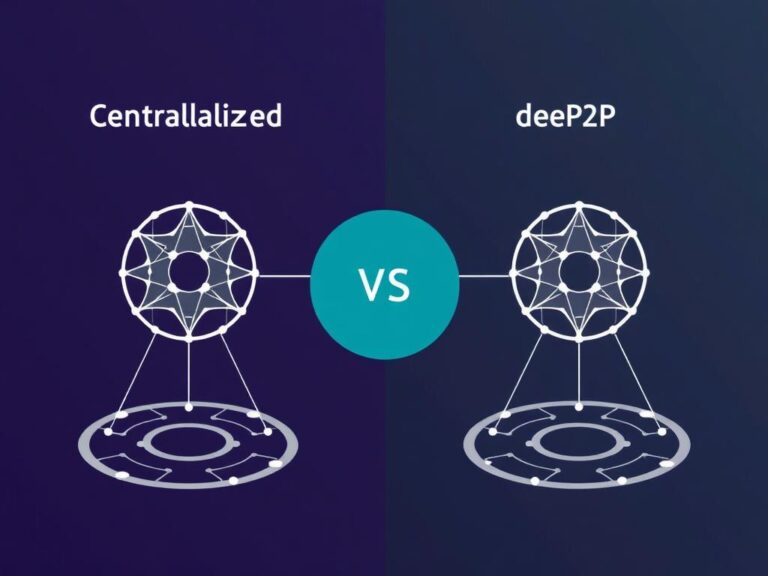IPFS (InterPlanetary File System) – The Future of P2P Storage?
Understanding the Basics of IPFS
The internet, as we know it today, relies heavily on centralized servers and data centers. Every time you load a webpage or stream a video, your device connects to a specific server to fetch that data. While this system has served us well, it has its drawbacks – from server outages causing websites to go down, to privacy concerns and heavy bandwidth usage. Enter IPFS, the InterPlanetary File System, a revolutionary approach to storing and sharing data using peer-to-peer (P2P) technology.
IPFS is essentially a protocol and network designed to create a decentralized and distributed file storage system. Instead of relying on a central server, IPFS allows computers around the world to store and share pieces of files with each other. When you request a file on IPFS, the system finds the closest or fastest available copy on the network, ensuring durability and speed. Think of it as a giant, distributed hard drive shared among millions of computers.
How Does IPFS Work? The Technical Side Made Simple
At its core, IPFS uses content-addressing instead of location-addressing. This means that files are identified by their actual content hash (a unique string generated through cryptographic hashing), not by the place where they are stored. When you upload a file to IPFS, it’s broken down into smaller blocks, each with a unique hash. These blocks are distributed and stored on various nodes across the network.
Here’s a simplified step-by-step of what happens when you upload a file to IPFS:
- The file is split into smaller chunks, each assigned a unique cryptographic hash.
- These chunks are distributed and stored on multiple nodes (computers) within the network.
- The file itself is identified by a combined hash that references all the chunks.
- When requested, IPFS retrieves the chunks from the nearest or fastest nodes to reassemble the file.
Because files are identified by their contents, if one node goes offline, other nodes with the same file chunks can serve the data. This design drastically reduces reliance on single points of failure and enhances file persistence.
Key Features of IPFS
- Decentralization: No central authority controls the data, making censorship much harder.
- Content addressing: Files are retrieved based on their content hash, ensuring integrity.
- Dedupe and versioning: IPFS doesn’t store duplicate data; it can version files efficiently.
- P2P network: Files are distributed and fetched among peers, cutting down latency and bandwidth costs.
- Offline availability: Local nodes can cache files, making data accessible even if disconnected from the main internet.
Why IPFS Could Be the Future of Peer-to-Peer (P2P) Storage

The traditional web faces challenges that IPFS aims to solve, particularly when it comes to data storage and sharing. Here are some compelling advantages that make IPFS a strong candidate for the future of P2P storage:
1. Increased Resilience and Redundancy
Websites and data hosted on centralized servers are vulnerable to outages, cyber attacks, or regulatory shutdowns. IPFS spreads data across multiple nodes, ensuring that even if some nodes go down, your data remains available elsewhere. This redundancy is an inherent feature of any robust P2P system.
2. Faster Content Delivery
When you access a file via IPFS, you retrieve it from the closest node holding that data. This can reduce latency and speed up access times, especially important for large files like videos or software updates. Traditional servers might be continents away from you, resulting in slower load times.
3. Enhanced Privacy and Security

Because IPFS doesn’t rely on centralized servers, it minimizes risks related to data breaches or mass surveillance. Each file is hashed cryptographically, so tampering or corruption becomes immediately detectable. Plus, users control which nodes hold their data.
4. Content Persistence and Ownership
One key challenge in the decentralized web is ensuring data persists over time. In IPFS, while data can be widely distributed, persistence depends on nodes choosing to “pin” files. However, the protocol itself empowers content owners to store and share data without relinquishing control to a central service provider.
5. Open Source and Interoperability
IPFS is fully open source, encouraging developers worldwide to build applications on top of it. Its HTTP gateway feature allows users to access IPFS content through regular web browsers, bridging the gap between decentralized and traditional internets.
Use Cases and Real-World Applications of IPFS
Many industries and projects have started experimenting with IPFS to take advantage of its distributed nature. Here are some notable examples where IPFS is making an impact or holds promise:
| Sector | Use Case | Benefits |
|---|---|---|
| Decentralized Websites | Hosting websites entirely on P2P networks | Resistant to censorship and downtime |
| File Storage & Backup | Distributed backups for critical data | Reduces dependency on cloud providers, increases redundancy |
| Blockchain Projects | Storing large off-chain data like NFTs and smart contract metadata | Cost-efficient and decentralized storage |
| Scientific Research | Sharing large datasets worldwide | Promotes open access and reproducibility |
| Media and Content Distribution | Streaming videos, distributing software | Faster downloads and reduced server costs |
Challenges and Limitations of IPFS
While IPFS is a promising technology, it’s important to recognize that it isn’t perfect yet. Here are some of the challenges currently facing IPFS adoption and development:
- Data Persistence: Since IPFS nodes can choose whether to keep (“pin”) files, important data could disappear if unpinned and no active nodes serve it.
- Scaling: Efficiently locating and retrieving files in a vast network can be complex and sometimes slow.
- Privacy Concerns: Files stored on IPFS nodes can be accessible to anyone unless encryption is used, raising confidentiality issues.
- Legal Risks: Decentralized content hosting could expose nodes to liability for copyrighted or illegal content they happen to store.
- User Experience: Current IPFS tools are still maturing, and for many users, they are not as seamless as traditional web services.
Despite these hurdles, ongoing research and improvements like Filecoin integration for incentivized storage and better user-friendly interfaces continue to push IPFS forward.
Getting Started with IPFS: A Quick Guide
Interested in exploring IPFS yourself? Here’s a simple checklist for beginners to dip their toes into this revolutionary network:
- Install the IPFS Client: Download and install the official IPFS desktop or command-line client from ipfs.io.
- Add Files: Use the client to add files to your local IPFS node, which will generate content hashes and share pieces on the network.
- Access Files: Retrieve files by their content hash (CID), either through the IPFS client or an HTTP gateway.
- Pin Files: Ensure important files stay available by pinning them locally.
- Experiment: Try hosting a simple static website using IPFS and share it with friends to get the feel of decentralized hosting.
IPFS vs Traditional Cloud Storage
Let’s compare IPFS with popular cloud storage providers to see where each stands out:
| Aspect | IPFS | Traditional Cloud Storage |
|---|---|---|
| Data Control | User-controlled; decentralized distribution | Controlled by provider; centralized access |
| Availability | Depends on network health and pinning | Generally guaranteed by SLA (Service Level Agreement) |
| Cost | Often free or incentivized via tokens; costs decentralized | Subscription or pay-as-you-go pricing |
| Security | Content hashed; data integrity ensured; encryption optional | Provider-managed security and privacy |
| Performance | Depends on node proximity; variable latency | Consistent fast access with CDN support |
Looking Ahead: The Future of IPFS and P2P Storage
IPFS represents a paradigm shift in how we think about data storage and sharing. Its distributed architecture aligns perfectly with increasing demands for privacy, decentralization, and resilience. As more decentralized applications (dApps), blockchain projects, and even traditional platforms begin to rely on IPFS, we will likely see improved infrastructure, increased adoption, and new innovations.
Combined with complementary technologies like Filecoin, which incentivizes storage and retrieval by rewarding participants, IPFS is not just a theoretical idea – it’s rapidly becoming a practical and scalable solution. Imagine a web where your data isn’t locked into one server or cloud provider, but instead safely spread across a vast network, accessible and secure.
As the internet continues evolving, IPFS and P2P storage could play a crucial role in building a more open, user-centric digital future.
Conclusion

In summary, IPFS brings a fresh and powerful approach to storing and sharing data by harnessing the potential of decentralized, peer-to-peer networks. Its innovative content-addressing system, greater resilience, and open-source nature set it apart from traditional storage models that depend on centralized providers. Although still evolving, IPFS addresses many of today’s web limitations, offering exciting possibilities for faster and more secure content delivery. While challenges such as persistence, privacy, and scalability remain, the momentum building around IPFS suggests that peer-to-peer storage isn’t just a futuristic concept but a reality increasingly shaping how we access and manage data. Whether you are a developer, a content creator, or just an internet user curious about the next phase of the digital revolution, keeping an eye on IPFS is well worth your time.






